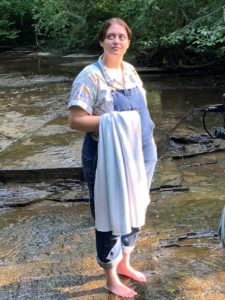Emerson’s Story
Why Craft? A Student Perspective
When I came to Berea College as a first-year student in 2017, I was assigned to work in the weaving studio in Student Craft. I had never woven before, but I had been doing various fiber arts since I was very young and I was excited about the opportunity to learn something I likely wouldn’t have had the chance to learn anywhere else. I didn’t realize how much weaving, and Student Craft in general, would change me and the way I view the world.
I was a biology major, which confused many of the people who visited Student Craft to learn about what we do here. What is a biology student doing at Student Craft? Most people assumed that it gave me a break from all the difficult science work that I was doing in the classroom. There are several implications in that assumption that I disagree with. One: that science is difficult and craft is not. Two: that craft and science are entirely distinct disciplines. I don’t see it that way at all. I am constantly finding connections between what I’ve learned in my studies and what I’m doing in Student Craft. One that I believe to be most important is the connection between craft and human evolution.
 As a biologist, human evolution has been discussed at length in my classes and in my field. Craft has played an important role in our evolutionary history, but it isn’t often seen or taught that way in academia. I have been told countless times that humans have survived to this point because we are adaptable, and while that’s true, it’s not the whole picture. Physiologically, humans are rather weak and fragile. We are also pretty much the same across the entire globe. So how is it that members of the same species can inhabit the whole range of climates our planet has to offer? The answer – and our true adaptability – lies in our ability to create and modify our environments to suit our needs, rather than modifying ourselves to suit our environments. We didn’t learn to cope with harsh winters by growing extra thick coats of fat or fur, we learned to make clothes and shelter and central heating. The earliest species in our genus, Homo, is called Homo habilis – meaning “handy man,” named for the incredible tools found near the fossils we have discovered. Creating is how we have survived to become the species we are today. Craft is, quite literally, in our genes.
As a biologist, human evolution has been discussed at length in my classes and in my field. Craft has played an important role in our evolutionary history, but it isn’t often seen or taught that way in academia. I have been told countless times that humans have survived to this point because we are adaptable, and while that’s true, it’s not the whole picture. Physiologically, humans are rather weak and fragile. We are also pretty much the same across the entire globe. So how is it that members of the same species can inhabit the whole range of climates our planet has to offer? The answer – and our true adaptability – lies in our ability to create and modify our environments to suit our needs, rather than modifying ourselves to suit our environments. We didn’t learn to cope with harsh winters by growing extra thick coats of fat or fur, we learned to make clothes and shelter and central heating. The earliest species in our genus, Homo, is called Homo habilis – meaning “handy man,” named for the incredible tools found near the fossils we have discovered. Creating is how we have survived to become the species we are today. Craft is, quite literally, in our genes.
Having studied human evolution in this way, working in Student Craft is so much more meaningful. Craft feels sacred to me – the act of creating connects me to a history millions of years old. While I will never truly know what it was like to exist as Homo habilis in Africa two million years ago, I like to imagine they felt the same sense of pride after finishing a tool as I feel when I finish a blanket. When I weave, I am continuing a story millennia in the making, adding my own thread to the threads of every weaver, every craftsperson who has ever existed in the beautiful tapestry of human existence.
Element Series
Hear from Emerson and their journey as a queer and non-binary person working in Berea College Student Craft. In this video, Emerson also talks about what it meant to create the Element series, a collection of non-gendered baby blankets from Student Craft.
This story is what draws me to craft. When we look at the vastness and richness of all that has been created and all that will be created, we find countless stories of every single object that was, is, and is yet to be. When a craftsperson makes something, they put a piece of themself and their story into that object. However, issues arise when only one type of person is allowed to share their story and their craft. When we only tell the stories of cisgender, heterosexual, middle class, able-bodied, white men, we lose part of that richness that makes craft so compelling. As a queer and nonbinary person, I especially appreciate that Student Craft is committed to telling the stories of people who, historically, have not had the opportunity to tell their stories authentically with as much support from an organization like this.
My hope is that Student Craft’s new direction and goals will set a precedent for Berea College and in the craft community. In a time where marginalized voices are not actually listened to and uplifted, Student Craft is taking concrete steps to ensure that students get to tell their stories in ways that feel authentic and accurate and good. I’ve had the opportunity to do this through the Elements series of baby blankets, an explicitly non-gendered line of four baby blankets inspired by the four elements. My goal with designing these blankets was to make something that was inclusive of nonbinary people like me. I want other marginalized craftspeople to look at the work we’ve done and be inspired to create something that represents themselves and tells their own story. I want other craft programs and organizations to look at the work Student Craft is doing and be inspired to give a platform to marginalized voices in similar ways.
Student Craft is working hard to honor the history of craft by paving the way for a future that is intentional and equitable. There is always progress to be made, and I am proud to work with an organization dedicated to making that progress happen.

